
Cryptocurrencies came to the world to become an alternative to the current financial system. As such, users must be able to pay in a shop as fast as with credit cards. It means that a transaction must be settled within a few seconds. Visa network processes an average of 150 million transactions every day. It is approximately 2 000 transactions per second (TPS). Such throughput is unreachable for current blockchain networks. Normal throughput of PoW networks is usually only a few dozen TPS. PoS networks can reach several hundred TPS.
Distributed networks generally suffer from serious scalability limitations, low throughput, and excessive storage required to maintain the state of the system and its transaction history. After some 5 years of inter-disciplinary research effort in IOHK, the Hydra paper was released. Scientists and researches from networking, multi-party computation, programming language, and consensus branches had to work together to come up with a scaling solution that fits well with blockchain and smart contracts. It is a major scientific achievement and a significant milestone in the development of Cardano. Ouroboros Hydra breaks new ground in PoS scalability. With Hydra, Cardano can really become the alternative to current fiat money.
Hydra is the second layer solution on top of the Cardano first layer where PoS consensus is used. Hydra is designed in a way that fits well with a stake pool model. The IOHK team introduced an extended UTxO model that allows sharding of stake space without the need to shard ledger itself. It is still possible to shard on the ledger level and Hydra is a complementary part of the whole scaling solution. Every pool can create a new Hydra’s head so adding more pools mean that more head can be added. So by adding new heads to the protocol nearly linear scaling can be achieved. Simulations have been done and the results are great. Each Hydra head can process around 1000 TPS and there is room for further optimization. So with 1000 pools, Cardano could be theoretically able to scale up to 1 million TPS and the finality of transactions will be very fast. Hydra enables horizontal scaling. It means increasing performance by incorporating additional nodes. It is always easier than to add additional powerful hardware since there are HW limits.
Hydra will ensure low latency and minimal storage of data per node. Hydra is also able to execute smart contracts so developers can easily build dapps and utilizing micropayments, voting, and other things.
It does not matter if you do not understand all that was written above. Let’s now deep into technical details.
What is the relationship between blockchain and Hydra
The first layer options will always be limited in terms of the number of transactions processed in a given period of time. If decentralization is not to be sacrificed, throughput will never be sufficient to allow a large number of people to use a consensual distributed network. The solution may be to create a second layer above the first layer. The first layer is what we call blockchain. It is the most secure and decentralized network with lower throughput. Above this first layer, it is possible to create a quasi-independent network, a second layer. The second layer is built to scale as high as possible and make transactions fast and cheap. So Hydra is the second layer solution for Cardano’s first layer.
Because the security of the first layer is ensured by blockchain and distributed consensus, we say that transactions are processed on-chain. Users will be able to transfer funds to the second layer. Transactions in the second layer are thus processed off-chain, meaning outside the blockchain. So the first layer does not verify transactions that take place in the second layer.
Let’s show it by example. Alice, Bob, and Carol each have 10 ADA coins in the blockchain, in the first layer. Altogether 30 coins. There is a special mechanism that allows transferring of coins into the second layer. In our case, into Hydra. To be more precise, the Hydra’s head is opened. In the Hydra’s head, all participants exchange coins through transactions. The first layer does not verify these transactions. Once Hydra’s head is closed, the blockchain will only take over the last valid coin distribution from the second layer. Will will discuss the transferring of coins between layers later.
Blockchain can easily verify that from the Hydra’s head expected 30 ADA coins are returned back to the blockchain. So exactly the same amount that was transferred to blockchain during opening Hydra’s head. Coin ownership may have changed in the second layer, with Alice now having 20 coins and Bob with Carol 5 coins. The advantage is that a large number of fast transactions between many users can take place in the second layer and the blockchain does not have to worry about it directly.
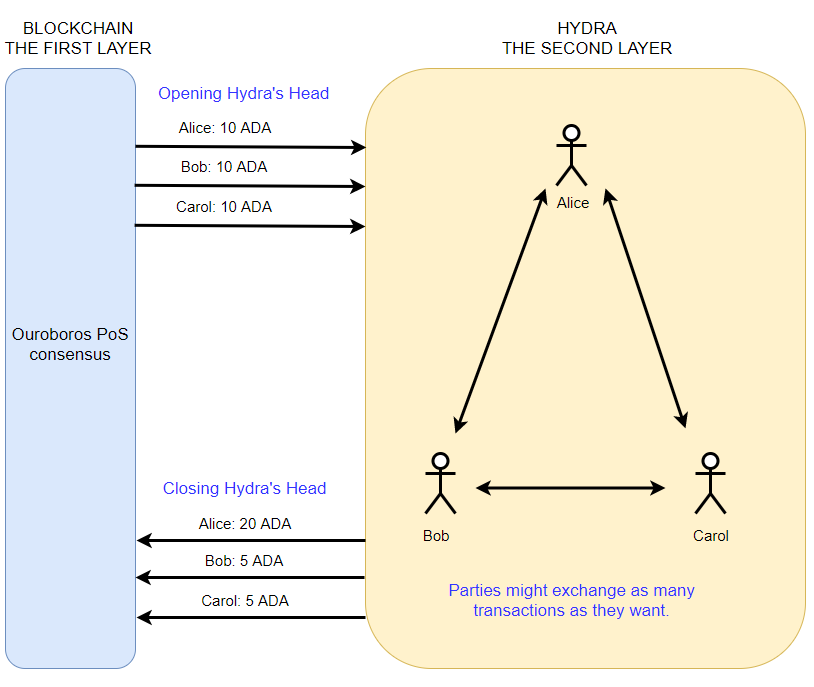
Alice, Bob, and Carol can communicate with each other directly in the Hydra’s head. It happens in a way that it is possible to forget the history of transactions. Parties update each other about local states and once it is confirmed among all of them the transaction history can be deleted. Thus only the last valid state is maintained in Hydra’s head and used when funds are to be transferred back to the blockchain. We will also discuss it in more detail later.
Hydra’s state channels
Hydra uses state channels, that extends the concept of payment channels. Parties maintain state channels to keep common state and they are able to agree on it without interaction with the blockchain.
Hydra is not only about transferring funds, but also about the execution of smart contracts. Thus it is necessary to work with states. For example, it is possible to create a smart contract in the first layer and transfer it into the Hydra’s head where can be executed.
You can imagine a smart contract as a program or sequence of certain operations that are executed conditionally. This means that an operation is only performed if an expected event has occurred. If not, another operation may be performed. We can talk about the event-driven execution of a smart contract. The smart contract is in a certain state at any moment, which gradually changes conditionally as long as it is active and the events trigger the changes.
Imagine a betting office where people can bet on the outcome of matches. The smart contract will be able to lock the deposits of all participants and then fairly distribute winnings based on the results of the matches. If we simplify it, the contract will be in several states per match.
- Collecting deposits and tips of participants before a match.
- Stop accepting deposits shortly before the match begins.
- Waiting for the match result.
- Processing the match result and calculating winnings.
- Distribution of winnings among winners.
The smart contract can be executed in Hydra and can be used for more matches in a row. Thus, blockchain cannot store all transactions related to bettings. History can be forgotten in Hydra. After the winnings are distributed to winners after the match, all states and transactions can be deleted. Except for the final state, of course. Let’s assume that the smart contract was created for a football season. Once the season ends, the Hydra’s head can be closed and all that will be stored in the blockchain is the final fund's distribution of bettors.

The concept of state channels is not new and there already are some existing implementations. However, they have some serious disadvantages. The biggest disadvantage is that the first layer infrastructure and smart contract code, that is written for the first layer infrastructure, cannot be used within the second layer without changes. These changes, that are needed for the transfer of funds and smart contracts between layers, might be very dangerous.
For example, the blockchain usually uses the UTxO model (Unspent Transaction Output). UTxO is basically an abstraction of coins. Each UTxO represents a chain of ownership implemented as a chain of digital signatures where the owner uses Private Key to sign a transaction that transfers ownership of their UTXO to the receiver’s Public Key. As we said, for simplicity, you can imagine UTxO as a representation of coin. Your coin holdings are defined by the number of UTxO you have in your wallet sitting on your addresses.
UTxO model is considered as a very secure way how to manipulate with funds within the blockchain. Current second-layer solutions are not able to work directly with UTxO. Coins are thus represented in a completely different way. The current second layers thus lose an important security element. The same is true for executing smart contracts where a conversion of information representation must occur. And it can be very dangerous.
Hydra significantly simplifies the second layer solutions. Hydra is able to adopt the first layer solution. Extended-UTxO model and the whole smart contract infrastructure of the first layer can be used within Hydra. Hydra’s transactions work directly with UTxO to change ownership. A smart contract, that is deployed in the blockchain, can be executed as-is in Hydra’s head and there is no data conversion.
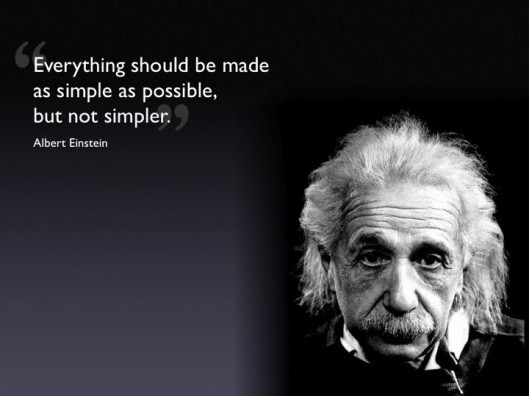
To see the difference more clearly, we can have a look at Ethereum. Ethereum uses Solidity for writing a smart contract in the first layer. When the contract is to be transferred to the second layer it must be converted since the second layer is not able to work directly with Solidity. To allow the conversion the Solidity smart contract itself must be adapted. The scripting language of blockchain and the second layer differ significantly. So the conversion is necessary.
In Hydra, no conversion is needed since both layers are able to use the same scripting system. Hydra introduces isomorphic multi-party state channels. It basically means that the scripting language of the underlying ledger is used by state channels. Hydra inherits the scripting language from Cardano blockchain.
State channels allow parallel processing of transactions and smart contracts, that happens off-chain. It is possible to open more Hydra’s head. So Hydra can be multi-headed. Every newly opened head represents a new parallel unit. Once a state channel is closed, the head state can be seamlessly absorbed by the blockchain. It is an easy and straightforward task since the same smart contract code is used on-chain and off-chain. It is even possible to create a smart contract in Hydra without registration in the blockchain. Blockchain is able to take over the smart contract and continue with execution on-chain.
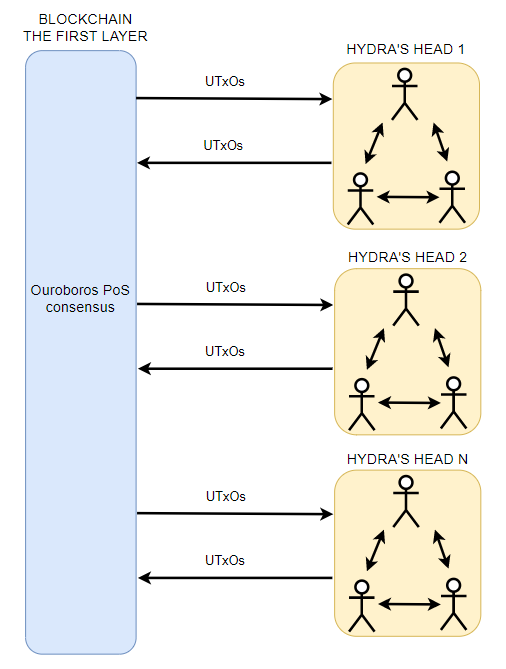
Thanks to Hydra, Cardano can scale nearly linearly. It means that when new resources are added into the network then more transactions and smart contracts can be processed. Performance increases. It is not always the case for blockchain. At least, it is not so easy.
Extended UTxO
Using the UTxO model in both layers is not for free and both layers must be prepared for it. Using isomorphic state channels require the ability to take a part of the blockchain state, process it independently outside in the Hydra, and finally be able to merge it back into the blockchain. UTxO is well suited for that and can represent the on-chain and the off-chain state. However, the traditional Bitcoin’s UTxO model is difficult to use for off-chain processing because of its limited scripting capabilities. IOHK introduced an Extended UTxO (EUTxO) model and support for a general state machine (we will discuss it later). The Extended UTxO model and the state machine allows a secure transfer between layers without scripting restrictions.
Transfer of UTxOs from the blockchain into Hydra’s head is coordinated by multiple parties. We talk about the opening of Hydra’s head. Head itself is the name of the second-layer protocol. In the beginning, after the transfer, there is an initial head state, that evolves in the Head protocol independently of the blockchain. Parties send transactions, execute smart contracts, and collectively maintain the common state. Due to the isomorphic nature, the same transaction validation, rules, and script execution can be used on-chain and off-chain.
Any party might wish to terminate the off-chain Head protocol. In this case, parties transfer the final head’s state back into the blockchain. Thus, the blockchain state is updated accordingly and is consistent with the final head’s state.
Hydra enables incremental commits and decommits. It means that UTxO can be added to or removed from Hydra’s head without closing and reopening the Head. It is very handy since there might be more parties involved and it would be unnecessary overhead to close the Head just because one participant needs to add or remove funds.
State machine
You might not be familiar with the term state machine. Put it simply, it is a mathematical model of computation. It is an abstract machine that can be in exactly one of a finite number of states at any given time. The state machine can change from one state to another in response to some inputs. The change from one state to another is called a transition. It is used within the Cardano first layer to be absolutely sure that the transfer of UTxO between layers is reliable and secure as there is only one valid state at every moment and transition to the next state is deterministic.

Imagine an elevator. The elevator can open and close the door. It can also move one floor up or down. Users can use buttons what is an input for the elevator. The elevator knows whether the door is closed or open and on which floor it is. These are also inputs. The elevator must never move with the door open. It would be dangerous for the people inside. The elevator will only move up/down when the door is closed. This is what the state machine can do. There are defined valid transitions from state to state. The elevator can work with states: Door open, Door closed, Move up, Move down, Idle. The valid transition from state to state is: Door closed -> Move up. Let’s describe the situation from the picture above. People are inside the elevator. The state is Door open. Somebody presses a button. It is an input for the elevator that results in closing the door. The state machine switches the state to Door close. After that, it is safe to transit to state Move up. An invalid transaction would be: Door open -> Move up. The elevator state machine ensures that the invalid transition can never happen. In other words, it ensures that only defined and expected transitions can happen. We have simplified it a bit but we hoped you got the idea.
Let’s go back to Hydra. The blockchain part of Hydra must ensure two things:
- It takes care of the locking of UTxOs in the blockchain as the UTxOs are transferred to the Head. The UTx0s stay locked in the blockchain while the Head is active. It happens when the Head is to be opened.
- When the Head is to be closed, it facilitates the settlement of the final Hydra’s state. It ensures that UTxOs are securely transferred back to the blockchain and decommited. It happens when the Head is to be closed.
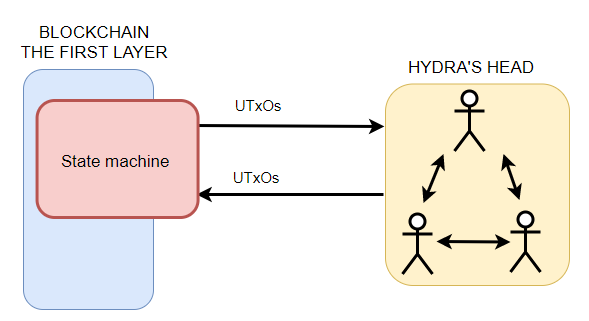
These two functions ensure that UTxOs that were used as the initial Head’s state are replaced by UTxOs that corresponds to the final Head’s state.
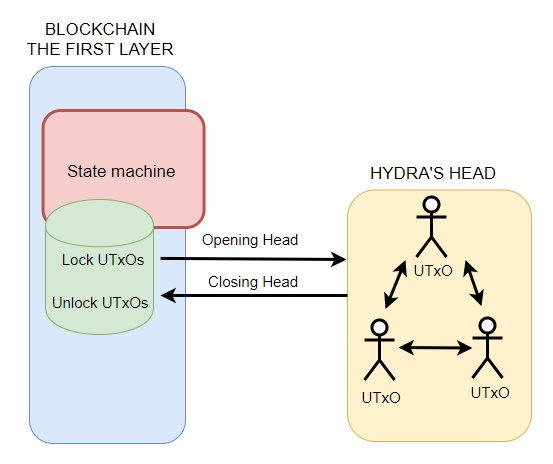
There are four states used within Hydra’s state machine: Initial, Open, Closed, and Final, and we will have a closer look at it right below.
It is probably unnecessary to deal with the state machine more deeply. It is important to know that the transfer of UTxO between layers is strictly and securely defined. A particular UTxO can be handled either by blockchain or by Hydra’s head. Never by both layers simultaneously.
The Head protocol
Any party can initiate the creation of Hydra’s head by asking a set of parties to join. Each party establishes a channel with all other parties. If it is not possible for any reason, the creation of the head is aborted. Parties exchange public-key material via established channels. The public key material is used for authentication of head-related on-chain transactions as only head members are allowed to do so. The material is also used for multi-signature-based event confirmation within the head.
The head initiator establishes the Head by submission of an initial transaction to the blockchain. Special tokens are created and assigned to all Head members. Thus, public keys of Head members can be linked with the tokens. At this point, the state machine gets involved and takes care of the secure UTxO transferring from the blockchain into the head. The first state is the Initial one. At this point, all Head members can commit UTxO into the Head. If any Head member fails to send the commit transaction then the state is switched directly from Initial to Final and the Head will not be opened. Let’s assume that all members succeeded in sending the commit transaction. In this case, UTxOs are locked within the blockchain to let the Head members work with them. The head members can start using UTxO within the Head once the state machine switches the state to Open. From that point, UTxOs begin to evolve off-chain.
At any point in time, when the Head is opened, any party might initiate closure of the Head. The state machine switches the state to Close. There is a contestation period during which parties provide their final state, which is their UTxO set. Once the contestation period elapses, the state machine switches the state to Final. Similarly, as at the beginning, the state machine takes care of the secure transferring of the UTxO set, which corresponds to the final Head state, back to the blockchain.
Let’s have a look at transaction processing in the Head. The Head protocol is asynchronous and it is able to process transactions parallelly. Each party maintains own final UTxO state. The Head protocol collects and distributes multi-signatures on each issued transaction. Once a transaction is confirmed it becomes part of the last valid UTxO state. The last valid UTxO state is irreversible, thus individual UTxO is immediately spendable. Due to the asynchronous processing, the party's final state might be different from each other. The UTxO evolves in time from the initial phase. Every party applies all transactions that have been confirmed in the Head and thus the final state can change constantly.
The Head protocol does not maintain the history of transactions to minimize the local storage of parties. Instead of keeping history, UTxO snapshots are constantly generated. There is always selected a snapshot leader that offers his view of the confirmed state. Other parties confirm the state by a signature and as a result, a new snapshot is generated. In contrast to asynchronous transaction processing, the snapshot is generated sequentially. Once a new snapshot is confirmed, parties might delete all transactions that have been processed and are part of the new snapshot. Party’s confirmed state is always ahead of the latest confirmed snapshot. Thus there is no need to wait for some transaction confirmation to be able to confirm a new snapshot proposal. Snapshot reflects the Head’s final state that has been confirmed by all Head members.
Would you like to have more information? You can read an article about Hydra on IOHK blog:
Summary
Hydra will enable what is absolutely necessary for further adoption of cryptocurrencies, and that is high scalability. Without this feature, the global system is basically unusable, because once people want to start using it, they will find it has to wait a long time for a transaction settlement. And often also pay extra. Hydra is a gamechanger. In addition to sending transactions, it also enables the execution of smart contracts. Moreover, everything is very safe compared to the competition thanks to the direct use of UTxO.
 Atala
Atala Must Blockchain be a slow and expensive Database? Cardano is going to rewrite History.
Must Blockchain be a slow and expensive Database? Cardano is going to rewrite History. How Cardano can help in Ethiopia, El Salvador and other developing countries
How Cardano can help in Ethiopia, El Salvador and other developing countries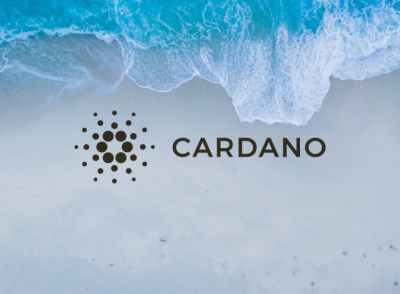 Why Cardano
Why Cardano